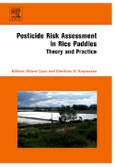Rice is cultivated throughout the world under submerged conditions. The high water requirements and the heavy pesticide load used in rice paddies worldwide have resulted in contamination of associated surface water, such as streams, ditches, rivers and lakes. The uniform risk assessment approach which has been developed for other crops is not applicable to rice paddies, because of the specific conditions applied to rice cultivation.
Pesticide Risk Assessment in Rice Paddies: Theory and Practice fills the gap in information on this subject. Written by experts, this book summarizes the methods used for pesticide risk assessment in rice paddies, the limitations and problems encountered and future developments. It also examines the various agronomic, pesticide application and risk assessment approaches used in different rice cultivated zones in Asia, America and Europe and is an essential reference for those working in this area.
Please Note: This is an On Demand product, delivery may take up to 11 working days after payment has been received.
Table of Contents
Proposed ContentsChapter 1: Agronomic, pesticide and water management in rice paddies (A. Ferrero).
Chapter 2: Regulatory Aspects of pesticide risk assessment (A. Craven).
Chapter 3: Water resource contamination in paddy areas (E. Capri).
Chapter 4: Ecotoxicological aspects of pesticide risk assessment in rice (J.V. Tarazona).
Chapter 5: Pesticide exposure assessment in rice paddies: the lower-tier analysis (R. Jackson, S. Cervelli).
Chapter 6: Higher tier exposure assessment in rice paddy areas a European perspective (D.G. Karpouzas, Z. Miao).
Chapter 7: Pesticide exposure assessment in rice paddy areas an Asian perspective (H. Watanabe, J. Tournebitze).
Chapter 8: Pesticide exposure assessment in rice paddy areas an American perspective (A. Ritter).
Chapter 9. Socio-economic assessment of the risk-benefit relationship in rice-cultivating countries(G. Canali).








